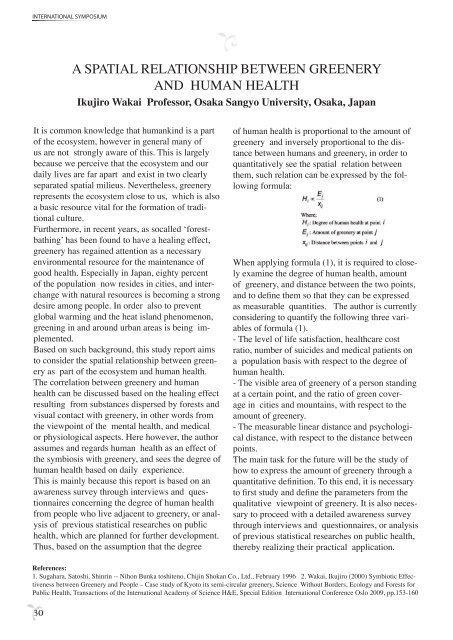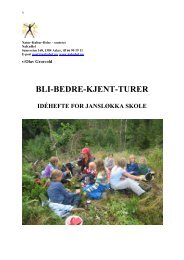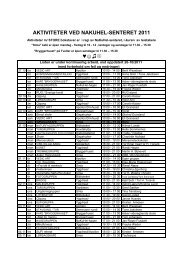Natur og Kultur som Folkehelse - NaKuHel
Natur og Kultur som Folkehelse - NaKuHel
Natur og Kultur som Folkehelse - NaKuHel
Create successful ePaper yourself
Turn your PDF publications into a flip-book with our unique Google optimized e-Paper software.
INTERNATIONAL SYMPOSIUM<br />
30<br />
A SPATIAL RELATIONSHIP BETWEEN GREENERY<br />
AND HUMAN HEALTH<br />
Ikujiro Wakai Professor, Osaka Sangyo University, Osaka, Japan<br />
It is common knowledge that humankind is a part<br />
of the ecosystem, however in general many of<br />
us are not strongly aware of this. This is largely<br />
because we perceive that the ecosystem and our<br />
daily lives are far apart and exist in two clearly<br />
separated spatial milieus. Nevertheless, greenery<br />
represents the ecosystem close to us, which is also<br />
a basic resource vital for the formation of traditional<br />
culture.<br />
Furthermore, in recent years, as socalled ʻ‘forestbathingʼ’<br />
has been found to have a healing effect,<br />
greenery has regained attention as a necessary<br />
environmental resource for the maintenance of<br />
good health. Especially in Japan, eighty percent<br />
of the population now resides in cities, and interchange<br />
with natural resources is becoming a strong<br />
desire among people. In order also to prevent<br />
global warming and the heat island phenomenon,<br />
greening in and around urban areas is being implemented.<br />
Based on such background, this study report aims<br />
to consider the spatial relationship between greenery<br />
as part of the ecosystem and human health.<br />
The correlation between greenery and human<br />
health can be discussed based on the healing effect<br />
resulting from substances dispersed by forests and<br />
visual contact with greenery, in other words from<br />
the viewpoint of the mental health, and medical<br />
or physiol<strong>og</strong>ical aspects. Here however, the author<br />
assumes and regards human health as an effect of<br />
the symbiosis with greenery, and sees the degree of<br />
human health based on daily experience.<br />
This is mainly because this report is based on an<br />
awareness survey through interviews and questionnaires<br />
concerning the degree of human health<br />
from people who live adjacent to greenery, or analysis<br />
of previous statistical researches on public<br />
health, which are planned for further development.<br />
Thus, based on the assumption that the degree<br />
of human health is proportional to the amount of<br />
greenery and inversely proportional to the distance<br />
between humans and greenery, in order to<br />
quantitatively see the spatial relation between<br />
them, such relation can be expressed by the following<br />
formula:<br />
When applying formula (1), it is required to closely<br />
examine the degree of human health, amount<br />
of greenery, and distance between the two points,<br />
and to define them so that they can be expressed<br />
as measurable quantities. The author is currently<br />
considering to quantify the following three variables<br />
of formula (1).<br />
- The level of life satisfaction, healthcare cost<br />
ratio, number of suicides and medical patients on<br />
a population basis with respect to the degree of<br />
human health.<br />
- The visible area of greenery of a person standing<br />
at a certain point, and the ratio of green coverage<br />
in cities and mountains, with respect to the<br />
amount of greenery.<br />
- The measurable linear distance and psychol<strong>og</strong>ical<br />
distance, with respect to the distance between<br />
points.<br />
The main task for the future will be the study of<br />
how to express the amount of greenery through a<br />
quantitative definition. To this end, it is necessary<br />
to first study and define the parameters from the<br />
qualitative viewpoint of greenery. It is also necessary<br />
to proceed with a detailed awareness survey<br />
through interviews and questionnaires, or analysis<br />
of previous statistical researches on public health,<br />
thereby realizing their practical application.<br />
References:<br />
1. Sugahara, Satoshi, Shinrin -- Nihon Bunka toshiteno, Chijin Shokan Co., Ltd., February 1996 2. Wakai, Ikujiro (2000) Symbiotic Effectiveness<br />
between Greenery and People – Case study of Kyoto its semi-circular greenery, Science Without Borders, Ecol<strong>og</strong>y and Forests for<br />
Public Health, Transactions of the International Academy of Science H&E, Special Edition International Conference Oslo 2009, pp.153-160





